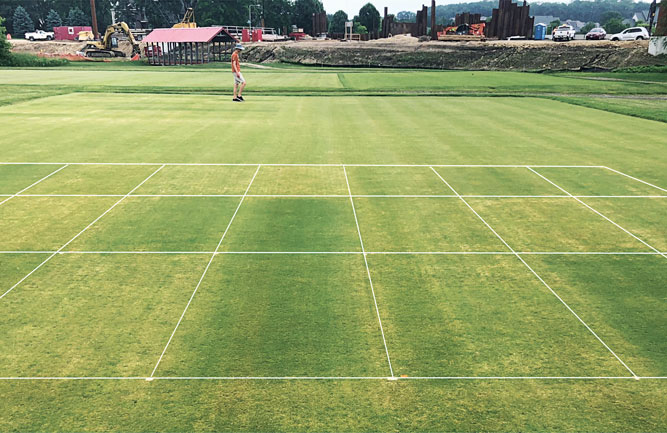Foliar fertilizers and soil nutrient levels
Foliar fertilization is the application of a dilute solution of plant nutrients to foliage with the objective of nutrient uptake by leaves. Initial interest in foliar fertilization began in the 1990s over concern about picking up granular fertilizers during mowing of putting greens, and the practice has become commonplace.
Some of the perceived advantages of foliar fertilizers compared to granular fertilizers are increased efficacy, accuracy and bypassing dysfunctional root systems during stress periods.
Past research on foliar fertilizers primarily has focused on nutrient uptake efficiency and turfgrass responses such as quality, clipping yield and root biomass. The effect of foliar fertilization on soil nutrient levels has not been researched. We wanted to determine the effects of foliar and granular fertilizers alone and in combination on creeping bentgrass performance and on soil nutrient levels. Specifically, we wanted to answer the question of whether foliar fertilization alone would decrease soil nutrients over time.
The experiment setup
We conducted research on a Penn A4 creeping bentgrass (Agrostis stolonifera L.) putting green at the Hancock Turfgrass Research Center at Michigan State University (Figure 1). There were two root zone mixes, an 80:20 (sand:peat, v/v) constructed to USGA guidelines, and a sandy clay loam (58 percent sand, 20.5 percent silt and 21.5 percent clay).
We initiated fertilizer treatments in June 2009. There were six fertilizer treatments, including three granular fertilizers applied approximately every 30 days; a foliar fertilizer applied at two rates approximately every 15 days; and a granular and foliar combination (we applied the granular approximately every 30 days and the foliar approximately every 15 days) (Table 1).
We collected soil samples to a 4-inch depth in October 2009 and June and October in 2010 and 2011. We measured soil P using Olsen extractant (0.5 M NaHCO3) as soil pH was greater than 7.4, measured soil K using 1M ammonium acetate and measured soil nitrate N using 1 M KCl. We visually rated turfgrass quality every two weeks on a scale of 1 to 9, with 1 equaling poor, 6 equaling acceptable and 9 equaling excellent.
Following granular fertilizer application, we applied 0.25 inch of water to move fertilizers into the canopy. We didn’t collect clippings for two days following granular fertilizer application to avoid picking up granular fertilizers. We irrigated the evening following foliar fertilizer applications and mowed plots, with clippings collected the following morning. Throughout the research we irrigated every other day, accounting for natural precipitation, to return 75 percent of reference potential evapotranspiration (ETp).
Results
Soil Nutrients
There were no trends in soil nutrients increasing or decreasing over the three years of our research (Table 2). Foliar fertilizer applications did not deplete soil NO3-N, P, and K after three years of fertilizer application. With respect to P the foliar and foliar 2X treatments were applied at 0.25 and 0.5 lb. P/1,000 sq. ft. per year, respectively. It previously was seen that applying 3 lbs. N/1,000 sq. ft. per year to a creeping bentgrass fairway with clippings removed decreased soil test P values by 3 ppm. However, applying 0.24 lbs. P/1,000 sq. ft. per year would maintain soil test P values. Our results for the foliar and foliar 2X treatments agree with the previous findings in that the applied P maintained soil test P levels. The granular treatments that applied only N also did not deplete soil nutrients over time, but this may be because of the timeframe over which the research was conducted. If the research were to continue for additional years, soil nutrient depletion may occur.
There were differences in soil nutrient levels (NO3-N, P and K) between the native soil and USGA root zone (Table 2). As expected, the native soil — which contains silt and clay fractions — had higher soil NO3-N, P and K levels than the USGA root zone across all sampling dates.
Although soil NO3-N is highly variable, the highest NO3-N level for either root zone was for the October 2011 sampling, when the USGA and native soil root zones had NO3-N of 2.3 and 4.3 ppm, respectively. Soil P for both root zones varied over time within a narrow range. The range in soil P for the USGA root zone was 14.5 to 19.6 ppm and 51.3 to 57.5 ppm for the native soil. There were no significant differences in soil K in the USGA root zone between the first sampling in October 2009 and the last sampling in October 2011. The native soil in the June 2011 sampling had the highest soil K while the June and October 2010 and October 2011 samplings had the lowest soil K. The range in soil K for the USGA root zone was 13.2 to 19.3 ppm, and the native soil was 75.1 to 88.9 ppm.
Soil P and K for the USGA root zone was below the MSU soil testing lab optimum guidelines of 20 to 30 ppm for P and 50 to 75 ppm for K, however, turfgrass quality (rating greater than 6) was acceptable for all fertilizer treatments. Recommended soil P and K sufficiency levels for turfgrass growth differ according to region, and laboratory and soil-testing extractant tend to be conservative to ensure nutrient deficiencies don’t occur.
The MSU soil testing lab uses the Sufficiency Level of Available Nutrients (SLAN) soil testing theory. The SLAN theory uses the amount of available nutrient extracted, expressed in ppm, to determine the need for fertilization. An alternative to SLAN guidelines, called the Minimum Level of Sustainable Nutrition (MLSN) has been introduced. MLSN identifies the minimum level of soil nutrients required for good turfgrass performance, and these levels are lower than optimum levels of SLAN.
For example, using MLSN, the highest Olsen soil test P level when P fertilization is recommended is 5.4 ppm, whereas the MSUSPNL guideline is 12. Although our soil test P levels did not decline to the MLSN 5.4-ppm level, our results tend to support that P and K levels below typical SLAN optimum levels can support healthy turfgrass growth.
Turfgrass quality
The combination and foliar 2X treatments had the highest turfgrass quality ratings throughout 2010 and 2011 (Table 3). Every two-week application of the combination and foliar 2X treatments had significantly higher turfgrass quality than the monthly methylene urea, urea and organic treatments on most dates. We think the difference in turfgrass quality ratings among the two-week applications of the combination and foliar 2X treatments and the monthly applications of granular methylene urea, urea and organic treatments was most likely due to the frequency of application, but our experiment was not designed to specifically answer that question.
Our results are similar to a 2008 study finding that combining liquid and granular fertilizers resulted in higher turfgrass quality. The foliar treatment with a lower N rate than all other treatments had acceptable quality throughout the research except on the April 2011 sampling date, when all treatments had unacceptable quality because of cool spring temperatures delaying spring green-up.
There were significant differences in turfgrass quality between the two root zones. There was only one date in three years — June 2009 — when turfgrass in the USGA root zone had higher quality than turfgrass in native soil. In 2010, turfgrass in the native soil had higher quality than turfgrass in the USGA root zone on five of seven dates, and there was no difference on two dates. In 2011, there were differences between root zones only for the June rating. Turfgrass in the native soil had higher quality. All quality ratings were above the minimum acceptable level of 6 except for April 2011.
No decreased levels seen
None of the fertilizer treatments, including the foliar treatments, decreased soil NO3-N, P and K levels after three years of application. Every two-week application of the combination and foliar 2X treatments resulted in higher turfgrass quality than the monthly methylene urea, urea and organic treatments. The foliar treatment, applied at one half the N rate of the other fertilizer treatments, maintained acceptable turfgrass quality throughout the research. Golf course superintendents who are using only foliar fertilizers should monitor soil tests to ensure nutrient levels are not declining, but given the timeframe and conditions of our study, there should be minimal concern that foliar fertilizers containing phosphorus and potassium deplete soil nutrients.
Miyuan Xiao is a former graduate student at Michigan State University and current graduate student at University of Guelph. Kevin W. Frank, Ph.D., and Thomas A. Nikolai, Ph.D., are turfgrass scientists at Michigan State University. You may reach Frank at frankk@msu.edu for more information.
References
Beard, J.B., and H.J. Beard. 2005. Beard’s turfgrass encyclopedia for golf courses, grounds, lawns, sports fields. Michigan State Univ. Press, East Lansing, MI.
Gaussoin, R., C. Schmid, K. Frank, T. Butler, H. Liu, and J. William III. 2009. Foliar uptake of nutrients applied in solution to creeping bentgrass (Agrostis palustris Huds.), annual bluegrass (Poa annua var. reptans (Hausskn.) Timm) and ultra-dwarf bermudagrass (Cynodon dactylon x C. transvaalensis Burtt-Davy). In: The Proceedings of the International Plant Nutrition Colloquium XVI, Univ. of California-Davis, Davis, CA. 26-30 Aug. 2009. Dept. of Plant Sciences, Univ. of California, Davis, CA. p. 1-10.
Guertal, E.A. 2010. Fertilization of bentgrass with commercial foliar products: greenhouse evaluations. App. Turf Sci. doi:10.1094/ATS-2010-0914-01-RS.
Kussow, W.R. 2004. Managing soil phosphorus. Golf Course News. Feb. 2004. p. 58.
Stiegler, J.C., M.D. Richardson, and D.E. Karcher. 2011. Foliar nitrogen uptake following urea application to putting green turfgrass species. Crop Sci. 51:1253-1260.
Stowell, L., and M. Woods. 2012. Minimum levels for sustainable nutrition (MLSN). In The Bouyoucos Conference on the Advances in Research on Soil Biological, Chemical and Physical Properties for Sustainable Constructed Rootzones. p. 21.
Totten, F.W., H. Liu, L.B. McCarty, J.E. Toler, and C.M. Baldwin. 2008. Efficiency of foliar versus granular fertilization: A field study of creeping bentgrass performance. J. Plant Nutr. 31:972-982.
Photo: Kevin Frank












